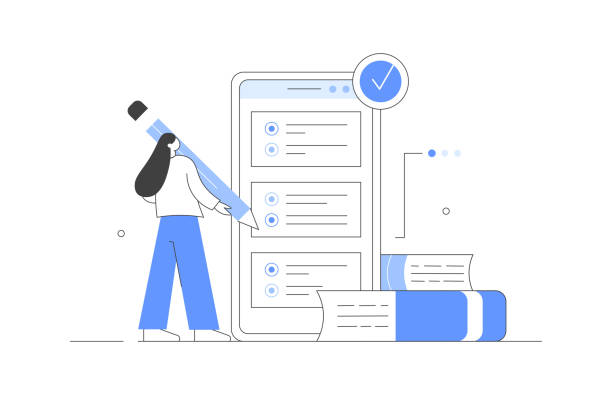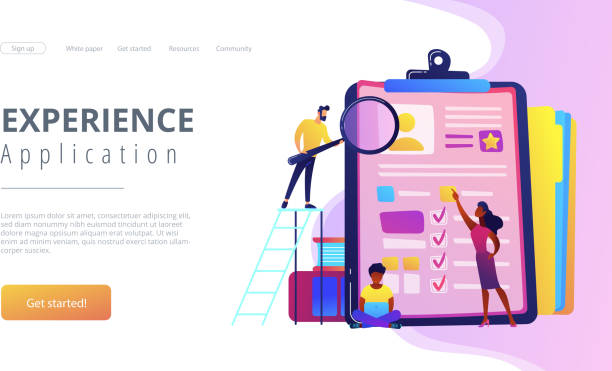Introduction to the Importance of Secure Website Design in the Digital World

#امنیت_سایت #تهدیدات_سایبری #اطلاعات_کاربران In the current era, where life and businesses are heavily intertwined with the online space, secure website design is no longer an option, but an undeniable necessity.
Websites have become the main storefronts for businesses, and any security flaw can lead to a loss of user trust, serious financial damage, and harm to brand reputation.
Given the increasing complexity of cyberattacks and malware, the importance of implementing strong approaches to website security becomes more apparent than ever.
Users’ personal information, financial data, and trade secrets are all at risk, and their protection must be a top priority for every website.
This section helps you gain a better understanding of the challenges and importance of web security.
According to recent reports, the number of cyberattacks on websites and database breaches has significantly increased.
These attacks are not only financially damaging but can also permanently destroy a brand’s reputation.
For example, a successful system intrusion can lead to the disclosure of credit card information or users’ identity data, which not only results in heavy penalties but also causes widespread customer distrust.
Consequently, investing in secure website design is not an expense, but a vital investment for the long-term sustainability and success of your online business.
Staying informed about the latest cybersecurity news can help you prevent many of these problems.
This news-explanatory article provides you with a comprehensive view of the current state of web security and the necessity of adopting preventive measures.
Falling behind in the competition with large online stores?
Rasaweb brings your business online with professional e-commerce website design and increases your market share!
✅ Increase brand credibility and customer trust
✅ Easy shopping experience leads to more sales
⚡ Act now to get a free website design consultation!
Basic Principles and Common Website Security Threats

#آسیبپذیری_وب #حملات_سایبری #OWASP_Top_10 To achieve secure website design, understanding basic security principles and being aware of common threats is essential.
These principles include things like input validation, proper session management, data encryption, and applying the principle of least privilege.
One of the most well-known resources for identifying vulnerabilities is the OWASP Top 10 list, which is updated every few years and introduces ten of the most critical web security risks.
Attacks such as SQL Injection, which allows an attacker to inject malicious SQL code into the database, or Cross-Site Scripting (XSS), which enables the execution of malicious scripts in the user’s browser, are among the most common threats.
Attacks like CSRF (Cross-Site Request Forgery), through which an attacker can trick a user into performing an unwanted action, are also serious risks.
Understanding these concepts and how these attacks work is the first step in combating them and ensuring your website security.
This educational-analytical section elaborates on these vulnerabilities and general methods to counter them.
Every developer and website owner should be familiar with these threats to adopt appropriate preventive approaches in the secure website design process.
Keeping knowledge up-to-date on new vulnerabilities and penetration methods can help you identify and fix potential weaknesses in your website.
This knowledge is vital not only for developers but also for website administrators to make informed decisions regarding security.
Implementing SSL/TLS Certificates and the HTTPS Protocol

#SSL #HTTPS #رمزنگاری_دادهها One of the most important pillars of secure website design is the use of SSL/TLS certificates and the HTTPS protocol.
SSL/TLS (Secure Sockets Layer/Transport Layer Security) are protocols that encrypt the communication between a user’s browser and the website server.
This encryption ensures that exchanged data, such as login information, banking details, and private messages, remain safe from any eavesdropping or manipulation by third parties.
Without HTTPS, all information is transmitted in plaintext, which can be easily viewed by anyone who can intercept network traffic.
HTTPS not only ensures data security but is also an important factor in SEO, as search engines like Google rank websites with HTTPS higher.
Proper implementation of an SSL certificate includes selecting the appropriate certificate type (DV, OV, EV), installing it on the server, and correctly configuring the website for mandatory HTTPS use.
This specialized guidance section helps you become familiar with certificate types and how to implement them.
Using HTTPS is no longer a luxury option, but a requirement for any website seeking website security and maintaining user trust.
This not only protects user information but also makes your website resistant to common MITM (Man-in-the-Middle) attacks.
| Certificate Type | Validation | Suitable For | Trust Level | Issuance Time |
|---|---|---|---|---|
| Domain Validation (DV) | Domain validation | Blogs, personal sites, small sites | Low | Minutes |
| Organization Validation (OV) | Domain and organization validation | Companies, organizations, commercial sites | Medium | Days |
| Extended Validation (EV) | Domain, organization, and legal validation | Banks, large online stores, government organizations | High (Green Bar) | Weeks |
The Role of Choosing a Secure Platform and Host in Website Design

#هاست_امن #CMS_Security #پلتفرم_وب Choosing a secure platform (CMS) and hosting is a crucial first step in secure website design.
Many websites are built on Content Management Systems (CMS) like WordPress, Joomla, or Drupal.
While these platforms offer fantastic features, if not properly configured and maintained, they can be weak points for attacks.
It is important to always use up-to-date versions of the platform and reputable, secure plugins.
On the other hand, website hosting plays a vital role in security.
A reputable hosting provider offers security measures such as hardware and software firewalls, intrusion detection systems, malware scanners, and regular backups.
Furthermore, server and resource isolation, access management, and continuous network traffic monitoring are characteristics of secure hosting.
Choosing cheap and unreliable hosting can nullify all your efforts for website security and put your site at risk.
This explanatory-guidance section helps you make informed decisions when choosing a platform and host for your website.
Reputable hosting companies often have security certifications and specialized support teams that can assist you in facing potential threats.
Considering these points in the initial phase of secure website design will prevent many future problems.
Additionally, reviewing the hosting provider’s security policies and ensuring they comply with current security standards is essential.
These steps are necessary and vital for any project, from a personal blog to a large online store.
Are you bothered by losing customers due to your e-commerce site’s outdated appearance or slow speed? Rasaweb’s expert team solves these problems with professional e-commerce website design!
✅ Increase customer trust and your brand’s credibility
✅ Stunning speed and excellent user experience
Get a free consultation with Rasaweb right now ⚡
Secure Coding and Software Vulnerability Remediation

#کدنویسی_امن #اعتبارسنجی_ورودی #OWASP_Sanitizing The heart of secure website design is robust and vulnerability-free coding.
Even with the best infrastructure and security configurations, if the website code has security holes, you will still be at risk.
Secure coding principles include strict validation of all user inputs (Input Validation), using Prepared Statements to prevent SQL Injection, and Output Encoding to combat XSS.
Never trust data coming from the user; always review and Sanitize it before processing or storing.
Additionally, secure error management, preventing the disclosure of sensitive information in error messages, and using strong cryptographic functions for passwords are other important considerations.
This specialized-educational section helps developers become familiar with best practices for secure coding and identify and fix common vulnerabilities in their code.
Continuous training of developers and keeping them up-to-date with the latest threats and best coding practices are key factors in increasing website security.
Automated software security testing tools (SAST and DAST) can also help identify vulnerabilities in the early stages of development.
The goal is that from the outset, secure website design is considered a fundamental principle throughout all stages of the Software Development Life Cycle (SDLC).
This proactive approach is far more effective and less costly than trying to fix security problems after attacks occur.
Access Management and Strong Authentication

#احراز_هویت #مدیریت_دسترسی #رمزعبور_قوی Proper access management and the implementation of strong authentication mechanisms are integral parts of secure website design.
Many breaches occur due to weak passwords, their reuse, or inadequate control over user access to the system.
To enhance security, websites should encourage users to use strong and complex passwords and implement Multi-Factor Authentication (MFA) for sensitive user accounts.
MFA provides an additional layer of security, so even if a user’s password is compromised, an attacker cannot access the account.
Furthermore, implementing the Principle of Least Privilege means that every user or system should only have access to the minimum resources and operations necessary to perform their tasks.
This minimizes the risk of intrusion and resulting damage.
Monitoring access logs and identifying suspicious activities are also crucial measures in this area.
This guidance-analytical section helps website owners and developers implement effective authentication and access management policies to ensure website security.
Strict control over access and continuous monitoring allows your website to be more resilient against internal and external attacks.
This comprehensive approach to security is a core pillar in securing a website against ever-increasing threats.
Regular Backups and Disaster Recovery Plans

#پشتیبان_گیری #بازیابی_اطلاعات #Disaster_Recovery No security system is completely flawless, and even with the best secure website design approaches, the possibility of a security incident (such as a cyberattack, hardware failure, or human error) always exists.
For this reason, having a regular backup plan and a Disaster Recovery Plan is of vital importance.
Regular backups of all website data, including the database, code files, media, and settings, ensure that in the event of a disaster, you can quickly restore your website to normal operation.
These backups should be stored in secure locations separate from the main server, preferably in cloud storage or on separate servers with restricted access.
A disaster recovery plan should include step-by-step procedures for system restoration, communication protocols during a crisis, and team roles and responsibilities.
This guidance-explanatory section helps you formulate an effective backup strategy and be prepared for worst-case scenarios.
The absence of a strong backup and recovery plan can lead to permanent data loss and prolonged website downtime, causing irreparable damage.
In fact, website security is incomplete without a robust recovery plan.
This measure not only protects your information but also brings peace of mind to you and your website users.
| Backup Type | Description | Advantages | Disadvantages |
|---|---|---|---|
| Full | Backup of all data | Fastest recovery | Large space, time-consuming |
| Incremental | Only changes since the last backup (full or incremental) | Less space, faster | Longer recovery (requires all files) |
| Differential | Only changes since the last full backup | Medium space, faster recovery than incremental | More space than incremental |
| Real-time | Continuous and instantaneous backup | Minimal data loss | High resources, high complexity |
Firewalls and Intrusion Detection Systems (IDS/IPS) in Secure Website Design

#WAF #IDS #IPS #امنیت_شبکه To bolster secure website design, the use of layered security tools such as firewalls and Intrusion Detection and Prevention Systems (IDS/IPS) is crucial.
Firewalls act as a barrier between the internal network and the Internet, filtering incoming and outgoing traffic based on predefined security rules.
Web Application Firewalls (WAFs) are specifically designed to protect websites against common Layer 7 attacks (such as SQL Injection and XSS) and can block suspicious traffic before it reaches the website server.
Intrusion Detection Systems (IDS) monitor network traffic and system activities to identify suspicious patterns or intrusion attempts and alert when a threat is detected.
Intrusion Prevention Systems (IPS) go a step further, and in addition to detection, they also have the ability to automatically block or stop attacks.
Implementing these tools provides stronger defensive layers for your website and significantly reduces the risk of intrusion.
This specialized-analytical section discusses the importance and function of these systems within the framework of website security.
These tools work synergistically, providing a defense-in-depth approach to protect your website against a wide range of threats.
Understanding how to configure and manage these systems is essential for anyone responsible for ensuring website security.
Is your online sales not as you expect? With Rasaweb, permanently solve the problem of low sales and poor user experience!
✅ Increase visitor-to-customer conversion rate
✅ Create an enjoyable user experience and boost customer trust
⚡ Act now to get a free consultation!
Continuous Updates and Website Security Monitoring

#بروزرسانی_امنیتی #نظارت_سایت #پچ_امنیتی One of the fundamental principles in secure website design and its maintenance is continuous updating and constant monitoring.
Software used on websites, from server operating systems to CMS platforms, plugins, and themes, is constantly evolving, and new vulnerabilities are regularly discovered.
Developers continuously release security patches and updates to address these vulnerabilities.
Failure to apply these updates promptly makes your website vulnerable to attacks that exploit these known security holes.
In addition to updates, active monitoring of website security is also highly important.
This includes reviewing server logs to identify suspicious activities, using vulnerability scanning tools to find weaknesses, and monitoring network traffic to detect attack patterns.
A strong alerting system can notify you of any anomalies or intrusion attempts so you can react quickly.
This guidance-news section emphasizes the importance of this proactive and reactive approach in maintaining website security.
Security patches are often released in response to the discovery of a critical vulnerability; therefore, applying them immediately can make the difference between security and intrusion.
Continuous monitoring allows you to become aware of problems sooner than attackers and take necessary measures to maintain secure website design.
Future Challenges and Innovative Solutions in Web Security

#امنیت_آینده #هوش_مصنوعی_در_امنیت #وب_۳ The challenges of secure website design in the digital world are constantly changing and becoming more complex.
With the emergence of new technologies such as Artificial Intelligence (AI), Internet of Things (IoT), and Web3, new threats also appear, requiring innovative solutions.
Attackers also use AI to automate attacks, analyze vulnerabilities, and create more sophisticated malware.
In the future, we will witness an increase in AI-based attacks, targeted attacks on IoT devices, and security challenges related to blockchain and decentralized technologies.
Innovative solutions for website security will include using machine learning for anomaly and attack pattern detection, identity-based security, Zero Trust security approaches (default distrust of everything and everyone), and using more advanced encryption techniques such as Homomorphic Encryption.
This thought-provoking and engaging section examines these future challenges and potential solutions to address them.
How can we ensure that as technology advances, secure website design keeps pace? Will AI help us defend better or empower attackers more? These questions occupy the minds of security experts and necessitate the development of creative solutions.
Preparing for the future and investing in advanced security technologies is the only way to ensure the sustainability and safety of websites against unknown threats.
Frequently Asked Questions
| No. | Question | Answer |
|---|---|---|
| 1 | What does secure website design mean? | Secure website design refers to a set of measures and methods employed to protect a website against cyberattacks, unauthorized access, data breaches, and other security threats. Its goal is to maintain the confidentiality, integrity, and availability of information. |
| 2 | Why is website security important? | Website security is vital for maintaining user trust, protecting sensitive information (such as personal and financial data), preventing financial losses, preserving brand reputation, and complying with legal regulations (like GDPR). A security breach can lead to customer loss and heavy fines. |
| 3 | What are some of the most common security attacks against websites? | Common attacks include SQL Injection, XSS (Cross-Site Scripting), CSRF (Cross-Site Request Forgery), Brute Force, DDoS attacks, Broken Authentication, and Missing Function Level Access Control. |
| 4 | What is the role of an SSL/TLS certificate in website security? | An SSL/TLS certificate (which leads to an HTTPS address) is used to encrypt data exchanged between the user and the website server. This prevents eavesdropping or tampering with sensitive information such as passwords and credit card details during transmission and verifies the website’s authenticity. |
| 5 | How can SQL Injection attacks be prevented? | To prevent SQL Injection, Prepared Statements or ORM (Object-Relational Mapping) with validated parameters should be used. Additionally, thorough filtering and validation of user inputs (Input Validation) and applying the principle of least privilege in the database are essential. |
| 6 | What is HTTP Strict Transport Security (HSTS) and how does it help with security? | HSTS is a web security policy that tells browsers to load the website only through an HTTPS connection, even if the user enters the address with HTTP. This prevents Downgrade attacks and cookie hijacking on public Wi-Fi networks. |
| 7 | What is the importance of regular software and plugin updates for website security? | Regular updates of the Content Management System (CMS), plugins, themes, and other software components of the site are crucial for addressing discovered security vulnerabilities. Developers continuously release security patches, and failure to update can make the site vulnerable to known attacks. |
| 8 | What measures can be taken to increase the security of the website’s administration section (admin panel)? | Changing the default admin panel path, using strong passwords and two-factor authentication (2FA), restricting access to specific IPs, using CAPTCHA on login pages, monitoring logs, and continuous CMS updates are among these measures. |
| 9 | Why is filtering and validating user inputs (Input Validation) important? | Filtering and validating inputs help prevent the injection of malicious code or unauthorized data through forms, URLs, or other user input sections. This prevents attacks like XSS and SQL Injection that exploit invalid inputs. |
| 10 | Name a few common tools or services for checking and enhancing website security. | Tools like Web Application Firewalls (WAF), vulnerability scanners (e.g., Acunetix, Nessus), Intrusion Detection and Prevention Systems (IDS/IPS), CDN services with security features (e.g., Cloudflare), and periodic Penetration Testing can enhance website security. |
And other services of Rasaweb Advertising Agency in the field of advertising
Smart Direct Marketing: An effective tool for campaign management with the help of attractive UI design.
Smart Social Media: A combination of creativity and technology to increase click-through rates through precise audience targeting.
Smart Data Analysis: A new service to increase website traffic through the use of real data.
Smart Advertising Campaign: A new service to increase sales through intelligent data analysis.
Smart SEO: Designed for businesses looking to increase click-through rates through attractive UI design.
And over hundreds of other services in the field of internet advertising, advertising consultation, and organizational solutions
Internet Advertising | Advertising Strategy | Advertorial
References
Website Design Security Guide on Zoomit
Website Security Checklist on Bartarinha
Website Security Articles for Businesses on IRWeb
Best Secure Coding Practices on ParsData
? To elevate your business in the digital world and be seen at the top, Rasaweb Afarin, a specialist in digital marketing services including corporate website design, is your professional companion.
📍 Tehran, Mirdamad Street, next to Bank Markazi, Southern Kazeroon Alley, Ramin Alley No. 6

